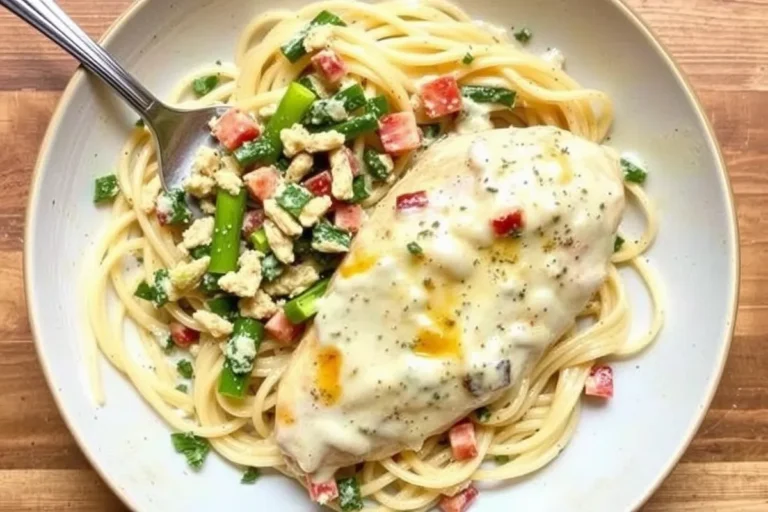Introduction to Chicken Alfredo
Chicken Alfredo is a beloved dish that has become synonymous with indulgent comfort food. Featuring tender, seasoned chicken atop creamy pasta bathed in Alfredo sauce, this meal is a staple in households and restaurants alike. But what makes Chicken Alfredo such a universal favorite? From its rich history to its global variations, let’s explore the factors behind this dish’s enduring appeal.
What is Chicken Alfredo?
Chicken Alfredo is a pasta dish that combines tender chicken with fettuccine pasta, coated in a luscious Alfredo sauce. This sauce, traditionally made with butter, heavy cream, and Parmesan cheese, is renowned for its rich and creamy texture. The balance of savory chicken and the luxurious sauce makes it a standout in the world of comfort food.
What distinguishes Chicken Alfredo is its simplicity. With just a handful of key ingredients, it delivers a dining experience that feels both elegant and homey.
Historical Background of Alfredo Sauce
Alfredo sauce originates from Italy, where chef Alfredo di Lelio created it in the early 20th century. Initially crafted to suit his wife’s delicate appetite during her pregnancy, this dish featured a simpler recipe of butter and Parmesan cheese tossed with pasta. Over time, the recipe evolved, gaining global popularity. Restaurants across the United States embraced the dish, adding cream for a richer flavor profile.
In recent years, Alfredo has become the basis for many variations, from seafood-infused delights to baked casseroles. Learn more about Alfredo’s history here.
Popular Variations of Alfredo Dishes
Chicken Alfredo is just one iteration of Alfredo-based dishes. Here are some popular variations:
- Shrimp Alfredo: Combining seafood and creamy sauce for a luxurious twist.
- Vegetable Alfredo: Featuring broccoli, spinach, or asparagus for a vegetarian-friendly meal.
- Alfredo Casserole: A baked version incorporating layers of pasta, sauce, and toppings like breadcrumbs or mozzarella cheese.
Each variation highlights the versatility of Alfredo sauce, making it a canvas for culinary creativity.
Why Chicken Pairs Perfectly with Alfredo Sauce
Chicken’s mild flavor makes it an ideal companion for Alfredo sauce. The creamy, cheesy nature of the sauce complements the savory richness of the chicken, creating a harmonious balance. Chicken’s protein content also makes the dish hearty and satisfying.
Whether grilled, sautéed, or baked, chicken adds a satisfying texture to the dish. Its versatility allows home cooks to experiment with seasoning and preparation techniques.
Cultural Influence and Global Adaptations
While Alfredo sauce originated in Italy, its adaptations worldwide reflect a diverse culinary influence. In the United States, it often features heavy cream for a velvety texture. In Asia, Alfredo-inspired dishes include local ingredients like sesame or soy sauce, resulting in fusion cuisine that honors both traditions.
Key Ingredients in Traditional Chicken Alfredo
To master the classic Chicken Alfredo, focus on high-quality ingredients:
- Chicken: Opt for boneless, skinless chicken breasts or thighs.
- Pasta: Fettuccine is traditional, but alternatives like penne or linguine work well.
- Alfredo Sauce: Stick to butter, cream, and Parmesan for authenticity.
- Seasonings: Garlic, black pepper, and Italian herbs enhance flavor.
Nutritional Value of Chicken Alfredo
Calories and Macronutrients
Chicken Alfredo is indulgent, with a serving typically containing:
- Calories: 800–1,200 per serving, depending on portion size.
- Protein: 25–35 grams, thanks to the chicken.
- Carbohydrates: 50–60 grams from the pasta.
- Fat: 30–40 grams, primarily from the sauce.
While rich in calories, the dish also provides a good balance of protein and carbs for energy.
Healthier Ingredient Substitutions
For a lighter version:
- Use low-fat milk or Greek yogurt instead of heavy cream.
- Replace butter with olive oil for a healthier fat option.
- Opt for whole-grain pasta or zucchini noodles for added fiber.
Small changes can make Chicken Alfredo a more nutritionally balanced dish without sacrificing flavor.
The Appeal of Chicken Alfredo Across Ages and Cultures
Chicken Alfredo has a universal appeal because it combines familiar flavors with a touch of decadence. Kids enjoy its creamy texture, while adults appreciate the gourmet feel it brings to the table. The dish’s adaptability also ensures it fits diverse dietary preferences and cultural tastes, making it a timeless favorite.
Step-by-Step Guide to Making Chicken Alfredo
Crafting a delicious Chicken Alfredo from scratch is simpler than it seems. With the right tools and fresh ingredients, you can create a restaurant-quality meal at home. Follow these steps for a foolproof result.
Essential Tools for Preparing Chicken Alfredo
Kitchen Appliances
- Stove or Cooktop: Essential for cooking both the pasta and the sauce.
- Oven (Optional): Perfect for baking chicken or warming the final dish.
- Blender or Food Processor (Optional): Helps in achieving a smooth sauce consistency.
Cooking Utensils
- Large Saucepan: Ideal for boiling pasta.
- Non-stick Skillet: Great for cooking chicken evenly.
- Whisk: Crucial for blending Alfredo sauce ingredients.
- Tongs: Helps toss pasta with the sauce efficiently.
Selecting the Best Ingredients
The quality of your ingredients greatly impacts the flavor of Chicken Alfredo. Choosing fresh, high-quality items is key.
Choosing the Right Chicken Cuts
- Chicken Breasts: Lean and tender, these are perfect for a classic Alfredo dish.
- Chicken Thighs: For those who prefer a richer flavor, thighs are a great alternative.
- Pre-cooked Chicken: A convenient option for quicker preparation.
Fresh vs. Packaged Alfredo Sauce
While store-bought sauces are convenient, homemade Alfredo sauce is unbeatable for flavor. Fresh ingredients like heavy cream, butter, and Parmesan cheese ensure a richer, more authentic taste.
Selecting Pasta for Alfredo Dishes
Fettuccine is the traditional pasta for Alfredo dishes because its flat, wide shape holds the sauce well. However, alternatives like penne, linguine, or even spaghetti can work. For a healthier option, consider whole-grain or gluten-free pasta.
Cooking Chicken Perfectly for Alfredo
Marination Techniques
Marinating chicken enhances its flavor and tenderness. A simple marinade of olive oil, garlic, Italian herbs, and a splash of lemon juice works wonders. Allow the chicken to marinate for at least 30 minutes before cooking.
Grilling, Baking, or Sautéing?
Each cooking method offers unique results:
- Grilling: Adds a smoky flavor and charred exterior.
- Baking: Ensures even cooking, making it ideal for thicker cuts.
- Sautéing: Quick and easy, it locks in the chicken’s juices.
For optimal results, ensure the chicken reaches an internal temperature of 165°F.
Preparing the Creamy Alfredo Sauce
Balancing Creaminess and Flavor
The secret to a perfect Alfredo sauce lies in its balance of ingredients. Use:
- Butter and Heavy Cream: For a rich base.
- Parmesan Cheese: Freshly grated for the best flavor.
- Garlic and Seasonings: Enhances the depth of flavor.
Cook the sauce over medium heat, whisking continuously to prevent lumps. Avoid overcooking, as it can cause the sauce to separate. Adjust seasoning to taste and add a pinch of nutmeg for a subtle aromatic touch.
Creative Twists and Serving Ideas for Chicken Alfredo
Chicken Alfredo is a classic dish, but its versatility allows for numerous creative adaptations and serving ideas. Whether you’re looking to add a bold twist, pair it with complementary side dishes, or elevate its presentation, there are endless ways to enhance this favorite meal.
Creative Recipe Variations
Spicy Chicken Alfredo
For those who love a kick of heat, spicy Chicken Alfredo is a perfect choice. Add the following to the sauce or chicken:
- Cayenne Pepper or Red Chili Flakes: For a gradual heat.
- Spicy Sausage: Incorporate it alongside the chicken for an extra layer of flavor.
- Hot Sauce Drizzle: A finishing touch to increase the spice level.
This variation pairs beautifully with a side of cooling cucumber salad or ranch-infused greens.
Vegan and Dairy-Free Alfredo Alternatives
For plant-based diners or those with dietary restrictions, Alfredo can be made dairy-free:
- Use Plant-Based Milk: Coconut or almond milk work well as substitutes for cream.
- Cashew Cream: Blended cashews create a creamy, rich sauce.
- Nutritional Yeast: Adds a cheesy flavor without dairy.
Replace chicken with grilled tofu or mushrooms for a satisfying vegan twist.
Perfect Side Dishes to Complement Chicken Alfredo
Pairing Chicken Alfredo with the right sides can elevate the meal into a complete dining experience.
Garlic Bread and Salads
- Garlic Bread: A crispy, buttery garlic bread complements the creamy pasta beautifully.
- Caesar Salad: Crisp lettuce, tangy dressing, and crunchy croutons provide a refreshing contrast to the richness of the dish.
- Caprese Salad: A light, tomato-based salad with mozzarella and basil adds a fresh element.
Wine Pairings for Chicken Alfredo
To enhance the flavors of Chicken Alfredo, pair it with the right wine:
- White Wine: Chardonnay or Pinot Grigio balances the creaminess of the sauce.
- Red Wine: Light reds like Pinot Noir can complement the dish without overpowering it.
Presentation and Garnishing Tips
A beautifully presented Chicken Alfredo can transform the meal into a fine dining experience.
For tips on achieving the perfect pasta texture, see expert advice from Bon Appétit here. »
Enhancing Visual Appeal
- Serve the dish in wide, shallow bowls for better sauce distribution and a professional look.
- Layer the pasta neatly with the chicken sliced and arranged on top.
Popular Garnishes for Alfredo Dishes
- Fresh Herbs: Parsley or basil adds color and freshness.
- Grated Parmesan: A sprinkle of Parmesan cheese gives the dish a finishing touch.
- Cracked Black Pepper: Adds a subtle spice and visual contrast.
Storing and Reheating Chicken Alfredo
Proper storage and reheating techniques can help preserve the flavor and texture of Chicken Alfredo for leftovers.
Refrigeration and Freezing Tips
- Store leftovers in an airtight container in the refrigerator for up to 3 days.
- For longer storage, freeze the Alfredo sauce separately from the pasta to prevent sogginess. Use freezer-safe bags or containers for up to 3 months.
Reheating Without Losing Texture or Flavor
- Stovetop: Reheat on low heat, stirring frequently. Add a splash of milk or cream to restore the sauce’s creaminess.
- Microwave: Heat in short intervals, stirring in between to ensure even warming.
- Oven: Cover the dish with foil and bake at 350°F for 15–20 minutes.
People Also Ask :
How can I avoid overcooking chicken in Chicken Alfredo?
To keep the chicken juicy, monitor the cooking time carefully and use a meat thermometer to ensure it reaches an internal temperature of 165°F without exceeding it.
What causes Alfredo sauce to become lumpy, and how can I fix it?
Lumpy Alfredo sauce usually occurs due to high heat or inadequate whisking. To avoid this, cook the sauce on medium-low heat and whisk constantly until smooth.
How do I prevent soggy pasta in Chicken Alfredo?
Cook the pasta al dente, following the package instructions. Immediately toss it with the sauce to maintain texture and prevent overcooking.
What is the best way to cook chicken for Chicken Alfredo?
The best methods are grilling, baking, or sautéing. Each adds a unique flavor, but sautéing is quick and locks in the chicken’s juices for tender results.
How do I make Alfredo sauce creamy without separating?
To keep Alfredo sauce creamy, cook it on low heat and stir continuously. Adding cream slowly while whisking prevents separation.
What pasta works best with Chicken Alfredo?
Fettuccine is traditional because its wide, flat shape holds the sauce well, but alternatives like penne or linguine are also popular.
Tips for Beginner Cooks
- Prep Ingredients Ahead: Have everything ready before you start cooking.
- Taste as You Cook: Adjust seasoning to your preference.
- Experiment Slowly: Start with the traditional recipe before trying variations.

